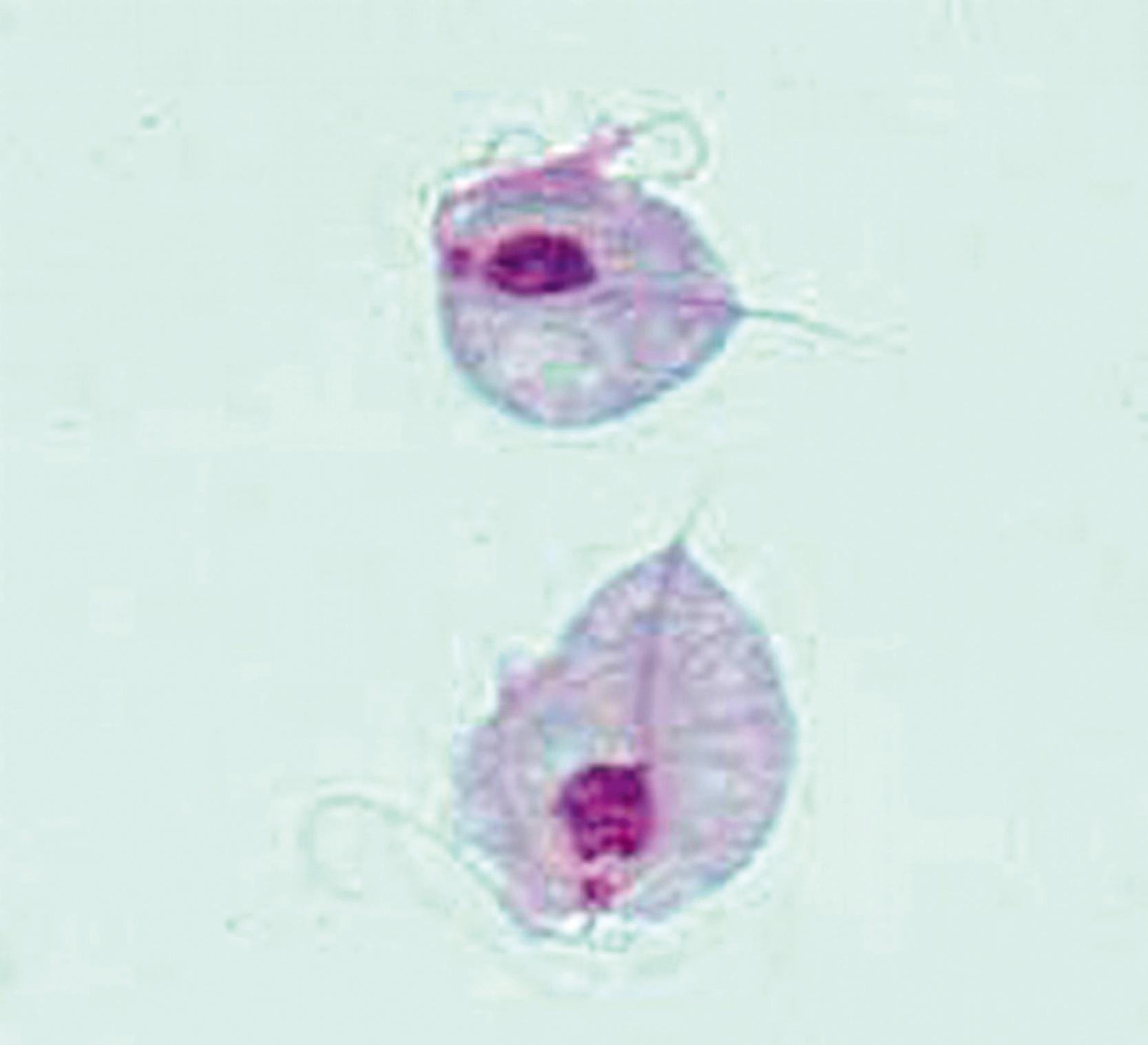Physical Address
304 North Cardinal St.
Dorchester Center, MA 02124
Trichomonas vaginalis can infect both men and women and is recognized as the most common nonviral sexually transmitted infection in the world.
T. vaginalis , a flagellated protozoan parasite, was first described in 1836 by French physician Alfred François Donné, who observed these “animalculi” in vaginal fluid under a light microscope. T. vaginalis eukaryotic parasites are typically oval or fusiform, 7–32 μm long, and 5–12 μm wide ( Fig. 274.1 ). Each has 4 anterior flagella that appear to arise from a single stalk, a central axostyle, and an undulating membrane that extends across the organism. The microbe contains a large anterior nucleus and well-developed Golgi bodies. The organism generates metabolic energy in membrane-bound chromatic granules called hydrogenosomes. All areas of the cell surface are capable of phagocytosis and can ingest bacteria, leukocytes, and other particles. T. vaginalis is facultatively anaerobic, uses a variety of carbohydrate sources, has limited biosynthetic capabilities, and grows in various liquid and semisolid media or in cell culture, especially in low-pH environments (i.e., pH 4.9–7.5). , The organism reproduces by binary fission every 4–6 hours.

T. vaginalis parasites exist only in trophozoite form, and humans are the only hosts. Parasites readily attach to mucous membranes by adhesion proteins and can damage epithelial cells by direct contact. , Epithelial damage also can be caused by contact-independent mechanisms, including soluble and membrane-associated enzymes associated with phospholipase A activity, which can lyse nucleated cells in vitro and contribute to tissue damage and inflammation. T. vaginalis can induce both humoral and cell-mediated immune inflammatory responses, but these responses are not protective and repeated and persistent infections can occur.
T. vaginalis infection is the most prevalent nonviral sexually transmitted infection worldwide. In 2018, it caused an estimated 5.1 million infections in the US among persons aged 15–59, including 4.2 million infections among women and 930,000 infections among men. T. vaginalis infection is not a nationally notifiable condition or reportable in any US state, and prevalence estimates are based on population and clinic-based surveillance studies. Based on analyses of the National Health and Nutrition Examination Survey (NHANES) 2013–2016 data, the US population–based T. vaginalis prevalence is 2.1% among females and 0.5% among males. , Among persons attending sexually transmitted disease (STD) clinics, the prevalence of infection has been reported to be 14.6%–27% among women and 9.8%–17% among men tested. Prevalence increases with age, peaking at more than 11% among women ≥40 years of age. , Prevalence of T. vaginalis is low among men who have sex with men. , Among adolescents in school grades 7–12, an estimated 2.8% of girls and 1.7% of boys are infected with T. vaginalis . A study, published in 2019, estimated T. vaginalis infection prevalence to be 0.7% among adolescent females aged 14–19 years old.
Health disparities by race or ethnicity are substantial. The highest rates of T. vaginalis are among non-Hispanic Black females (9.6%) and non-Hispanic Black males (3.6%) compared with non-Hispanic White females (0.8%) and Hispanic females (1.4%). , Rates are high among incarcerated populations, with reported prevalence of 9%–32% among incarcerated women and 2%–9% among incarcerated men. , Among women using drugs, the prevalence of T. vaginalis infection ranges 13%–38%. Additional reported risk factors for T. vaginalis include having two or more sex partners during the previous year, having less than a high school education, and living below the poverty level.
Transmission results almost exclusively from sexual contact during penile-vaginal sexual intercourse, though can occur through transmission of infected vaginal fluids or fomites among women who have sex with women. T. vaginalis does not commonly cause oral or rectal infections. Perinatal transmission of trichomoniasis can occur; the presence of T. vaginalis in a child beyond the perinatal period is suggestive of sexual abuse. ,
Approximately 70%–85% of T. vaginalis infections are asymptomatic. , Initial symptoms, when present, develop within 5–28 days after infection. Untreated infections can last for months to years. ,
Women can develop signs and symptoms including vaginal discharge, vulvovaginal irritation, dysuria, and dyspareunia. Lower abdominal pain is less common. Associated vulvar and vaginal erythema with copious frothy discharge pooling in the posterior vaginal fornix can be present. Punctate hemorrhagic lesions in the genital epithelium can result in colpitis macularis (“strawberry cervix”), a finding specific for trichomoniasis. Discharge ranges in appearance but can be yellow green, malodorous, and diffuse. , The differential diagnosis of vaginal discharge includes bacterial vaginosis, candidal vulvovaginitis, and cervicitis related to other sexually transmitted infections such as Chlamydia trachomatis or Neisseria gonorrhoeae . A meta-analysis revealed that T. vaginalis was associated with a 2.1-fold increased risk for cervical cancer. T. vaginalis infection is associated with preterm delivery and an increased risk for human immunodeficiency virus (HIV) infection.
Men may develop symptoms of urethritis or, less commonly, epididymitis or prostatitis. Men with trichomonas may have symptoms including urethral discharge, dysuria, and pruritus. , T. vaginalis is responsible for 1%–8% of cases of nongonococcal urethritis in men, depending on location and population. T. vaginalis urethritis cannot be distinguished clinically from nongonococcal urethritis caused by other pathogens, such as Mycoplasma genitalium or C. trachomatis. In areas where T. vaginalis is prevalent, men who have sex with women with persistent or recurrent urethritis should be tested for T. vaginalis and presumptively treated.
Become a Clinical Tree membership for Full access and enjoy Unlimited articles
If you are a member. Log in here